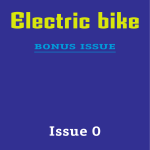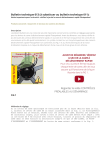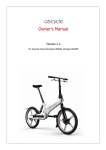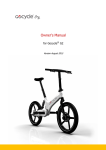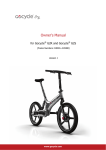Download Review: “Getting on with the Gocycle” - Green
Transcript
CON T E N T S JUNE 2009 Velo Vision Sample Article This PDF is a sample of the material in Velo Vision Issue 34, June 2009. The full contents page is shown opposite. To get an idea of our current output, please visit: www.velovision.com where you will find, amongst much else, full subject/author indices, sample articles to download and an online shop where you can subscribe, on paper or in a digital edition. If you have any problems or suggestions about the magazine in general, or this PDF article in particular, please email me at [email protected] I hope you enjoy the read. Peter Eland Editor and Publisher, Velo Vision Technical notes This Acrobat PDF file should display correctly on almost any computer. If you encounter problems the first thing to try is to download the latest version of Acrobat reader from the Adobe website: www.adobe.com If that fails, please send me an email and I’ll try to sort it out. Small print I don’t much like copy protection and legalese, but a few things need saying: You are free to print the document out for your personal use, but not for resale or for anyone else. Please do not make it available online without permission. To protect the copyright of Velo Vision and of our contributors, modification of this document, and copying of the contents, may have been disabled. Words and images remain copyright Velo Vision and the original contributors. Please don’t reproduce anything without express permission. Velo Vision is published quarterly by Velo Vision Ltd. Subscription details, news and updates can be found on www.velovision.com ISSN 1475-4312 Velo Vision Magazine York Eco Business Centre Amy Johnson Way Clifton Moor York, YO30 4AG, UK Tel/Fax +44 1904 692800 (from UK, 01904 692800) Email [email protected] Website www.velovision.com EDITOR AND PUBLISHER: Peter Eland EDITORIAL ASSISTANT: Sue Archer PHOTO ASSISTANT: Debz Butterworth ART DIRECTOR: Brian Holt WEB PROGRAMMER: Simon Ward PRINTER: Stephens & George Magazines Ltd PUBLISHING SCHEDULE: Issue 35: September 2009 Issue 36: December 2009 Issue 37: March 2010 Issue 38: June 2010 Velo Vision is a member of INK, trade association of the alternative press in the UK. www.ink.uk.com Velo Vision and Velo-Vision We weren’t first with the name. Velo-Vision is a bike shop in Körten, near Bergisch-Gladbach, Germany. Velo Vision magazine exists in friendly harmony with Velo-Vision in Germany. Velo Vision is printed on paper produced from sustainable forests to Nordic Swan standards. News 34 Folding bike recalls, new bikes galore, Moscow trike update, pioneering ocean pedalling and more. 10 SEN and the art of cycle training How specialist instruction can enable pupils with cognitive issues to exceed all expectations and learn to cycle. 34 Novatec dynamo set: is £30 for a hub dynamo too good to be true? 36 Book reviews: The Golden Age of the Handbuilt Bicycle, Live to Ride novel, plus the beginner-friendly Bike Easy 38 Book reviews: Bike Builder’s Bonanza, and the Pedaling Revolution 40 Terracycle idlers and accessory mounts: worthwhile upgrades? 13 Taipei 2009 42 A quick look at some of the innovations on show at the Taiwanese trade show in March. 14 SPEZI 2009 42 Folder fettling: readers’ Brompton mods. 44 The Seacycle: canal cruising by pedal power. 46 A trio of trikes: a reader reports from the rough roads of Moldova. 47 Above or below? Pros and cons of changing from below to above-seat steering. 4 Full report from April’s Special Bikes Show in Germany. 22 Review: Gocycle Full review of a production Gocycle, the potentially revolutionary compact urban run-around – with lightweight electric assist! 27 Review: KMX Cobra A recumbent trike for £999, but is it a practical machine for road riding? We test it to find out. 30 Review: Taga and Zigo child-carriers Brief reviews of two transforming trikes; they convert from child-carrying three- wheelers into full-featured strollers. Are they the perfect versatile kids’ taxis? On the move COVER: Gocycling! Photo: Peter Eland OPPOSITE: A swarm of bees on parked bikes in Bishopthorpe Road, York, provided an unusual sight for shoppers. Photos: Arthur Clune As you’ll read in the News section, and see in the masthead details above, we moved premises in late May, and we’re now happily settled into our much larger office at the Eco Business Centre on the north edge of York. Please do use the new address if you need to contact us or send anything. We’ve also been on the move to the SPEZI, with another convivial coach trip to a packed weekend of cycling and innovations, as you’ll see in our full report. Short Reviews Readers’ bikes 48 Kyoto cuties Velo Vision readers visit Japan and are enchanted by the small-wheeled wonders… 50 Letters More mystery cycles, the wrong trousers, historic cycle reportage, the Cleland concept clarified and much more.... 53 Subscribe to Velo Vision How to subscribe, back issues, and details of our distributors worldwide. 54 Advertisements The first place to look for specialist products and services! Please support our advertisers, who support the magazine. Finally, we’ve been moving ourselves around on a fascinating range of review bikes this issue, all in their own ways innovative and interesting. The Gocycle and Taga in particular are rare instances of ‘designer’ concepts embodied as practical, useful products – but do their looks get in the way? Is the simplicity and affordability of more traditional cycle engineering, as on the Zigo or KMX, a better bet? There’s an easy way to find out – read the reviews and decide for yourself! Peter Eland ISSUE 34 JUNE 2009 VELOVISION 3 PRO D U C T R E V IE W GOCYCLE GETTING ON WITH THE GOCYCLE It’s a bike like no other, a compact electric-assisted bike which also packs down superbly small. So can the Gocycle live up to the promise of its appearance? We tried one of the first production machines to find out. BACKGROUND The Gocycle has had a long gestation, from the early prototypes which designer Richard Thorpe showed to us back in the early days of Velo Vision to today’s finished article. As we described last issue, the first batch of bikes were placed with ‘beta’ test riders for several months before production of the current machines commenced – so that any weaknesses would be exposed and could be fixed. Production has now moved to the UK, and Gocycle are busy developing a dealer network. Overseas distribution arrangements are expected to be in place shortly, too. As we go to press, orders placed now expected to be delivered in August. Some dealers may have them in stock, though. The Gocycle is now only available complete with its electric-assist 22 VELOVISION ISSUE 34 JUNE 2009 system, which they call the ‘Empower Pack’, and in this form the bike costs £1158 (simple assembly required) or £1198 (assembled or via dealers). As you’ll see later, it fits together very easily, so I’d suggest saving a few pounds and going for the first option. Our bike came fitted with the optional lightweight kickstand (£35), the lighting set (£25). The mudguards and integrated cable lock are included as standard. Luggage-carrying is provided in the form of a stem-mounted front pannier rail (£14) from which you can hang a full-size pannier (max 5 kg), and/or a rear luggage arm (max 15 kg recommended). This follows the contour of the rear mudguard and provides a platform onto which a variety of hard-shell luggage can be attached using Ortlieb’s quickrelease plate system. Other accessories available include the hard-shell carry case (£90) and a fabric carry bag with foam insert (£40). A heavy-duty two-leg stand is also available for extra stability (£30). Finally, anti-theft bolts (£10) are available to make the wheels not quite so quick-release and tempting to the mischievous or light-fingered! FIRST IMPRESSIONS As you can see from the photos the Gocycle is a radical departure from conventional cycle design – and most would agree it looks fantastic: modern, stylish and smart. The smooth curves, classic black/white colour scheme and five-spoked wheels all contribute to the very ‘clean’ look: there’s little of the fussy BELOW: The five-spoke wheels are, like the frame, made from cast magnesium. detail of spokes, chain and loose cables which many bikes display. The frame is cast from magnesium alloy, coated to prevent corrosion, and it’s flawlessly finished in pure white. The frame has a 100 kg weight limit for rider, clothing and luggage. The user manual (supplied in digital PDF format on a USB memory stick) is full of reasonable enough exhortations not to let it sit around wet, perhaps as much for the sake of the electronics as for the frame. The frame does have a lifetime warranty, and there's a two year warranty on other parts. And because the bike uses so many nonstandard components, if anything goes wrong Gocycle say they will simply ship out replacement parts, modules or even complete bikes on a next-day courier service, either direct to the customer or via dealers, to fix the problem. One of the main features of the frame is that the rear swingarm completely encloses the chain drive system, so when manhandling or riding the bike there’s no need to worry about getting chain muck on your clothes. The enclosed drive should last indefinitely without maintenance, too. A three-speed hub gear in the back wheel gives gear ratios of 35", 53" and 71". The wheels, with slick, wide 20" (406) tyres, are Gocycle’s own design, again moulded in magnesium with five spokes apiece. They lock to the hubs via three curved levers; the action is very positive and securefeeling. The wheels certainly look good, but the user manual strikes a note of caution, urging checks for ISSUE 34 JUNE 2009 VELOVISION 23 PRO D U C T R E V IE W GOCYCLE fatigue cracks every 500 miles or so, particularly at the spoke heads. Each wheel is equipped with a mechanical disk brake, which stays in place when the wheels are removed. Wisely Gocycle have provided a shroud for each disk, so avoiding a common problem with disk brakes – the ease with which you can bend a rotor. Sure, the shrouds reduce the ventilation a bit, but that’s unlikely to be a problem for this type of bike. The stem assembly is pleasingly chunky, and it’s angle-adjustable in three settings. Height is also adjustable via a solid Allen key clamp. The cables are guided neatly down through the stem, entering just below the handlebars. The bars themselves have ‘soft touch’ padding to create a smooth taper from centre to end, again contributing to the clean lines. A twist-grip for the gears and a small bell adorn the righthand side, while on the left there’s the push button for the electric assist system. The saddle and seatpost are again chunky, large-diameter tubes finished in satin black. Instead of using a standard quick-release, saddle height is adjusted using a long lever just under the saddle; this expands an internal wedge to lock it into the lower section at your chosen height. A small thumbscrew lets you remove the ABOVE LEFT: The stem can be locked into any of three positions to adjust the reach. ABOVE: The power button and not very comfy grips. ABOVE RIGHT: Note the long lever just below the saddle, used to lock or unlock the seatpost for height setting. LEFT: The motor is discreetly built into the front hub. Note the USB port on the fork blade. FAR LEFT: Cables are neatly gathered in plastic mesh sleeves. 24 VELOVISION ISSUE 34 JUNE 2009 whole assembly (see later). On then to the electric assist system. The motor is a discreet unit built into the front wheel. The NiMh type batteries are concealed within the main frame. Control electronics are also built in. There's even a USB port on the front fork leg to allow you or Gocycle to connect the bike to a computer for reprogramming if firmware updates are ever necessary. A substantial ‘smart’ battery charger is provided – Gocycle recommend you leave the machine on standby charge all the time, for best battery life. With cables, it weighs around 1 kg. There's a noticeable cooling fan noise when actually charging, but it's silent on standby. The mudguards are stayless, cantilevered out from their support points, but were nonetheless remarkably rigid and flop-free. Substantial aluminium ribs run up the underside of each of them. They did run close to the tyre, and any grit on the road would rattle up there rather. But again not a problem – this isn’t the bike for muddy tracks or riding in snow. The ‘Shocklock’ cable lock (weighing 655 g) is fitted through the bike’s shock absorber for carrying. Extended, it’s long enough to lock through both wheels of the bike, and unless you’ve got the anti-theft bolts this might be wise. It's certainly handy for low-risk situations, perhaps for locking the bike up outside a cafe where you can keep an eye on it. But cable locks are notoriously easy for thieves to cut, so for higher-risk areas a more effective combination would be those bolts for the wheels plus a decent D-lock, carried on your person perhaps. Gocycle also offer a heavier-duty chain lock (£70), but I've not seen it yet. Then again, this is the sort of bike you’d probably only choose for commuting if you have secure parking at each end of your journey. The lighting system is simply two small LED lights, attached neatly to the fork crown and under the saddle. Definitely lights to make you legal and to be seen by – you could easily fit a more powerful battery light to the handlebars if you needed more. Last but not least, the lightweight twin-leg stand folds up remarkably small – so close against the frame that it’s easy to miss. It did a good job of holding the bike up on firm surfaces, but if you use it a lot I’d go for the heavyweight version for extra stability. Weight as tested was around 17.5 kg, including all of the accessories. That matches up with their claimed weight of 16.2 kg with electric package and mudguards. Without these, the bare bike apparently weighs just 11.9 kg. Either way, it's extremely light as electric bikes go, and weighs less than a good few non-electric machines! Shimano Nexus hub gear, seemed reasonably efficient, and the bike's rigidity also contributed to a feeling of an instant response to pedalling effort. I found the ratios (35", 53", 71") well suited to urban use, especially if you’re happy with a fairly high cadence. That low gear is certainly good for acceleration from a standstill. Some riders who preferred a lower cadence did find it undergeared, and if you can’t spin fast it does force you to rely more on the motor to achieve decent speed. So to the electric assist. To turn it on you just press the red button, and wait a moment or two for the motor to kick in. As delivered, the bike is set to 'UK mode' which does not require you to be pedalling for the motor to operate. If you take it to mainland Europe you'll need to switch it to 'EU mode' to stay legal, as most of these countries require pedalling for power assist to cut in. Swapping over is simply a matter of holding down the power button and releasing it after the appropriate series of beeps. In either mode the motor cuts out as your speed reaches 25 km/h (16 mph). There's also a lower bike speed limit below which the motor THE RIDE The Gocycle is a very rigid bike, and it instantly feels remarkably stable and solid. The stem assembly, often a weak point on small-wheeled bikes, felt strong and flex-free. The big fat slick tyres helped give it a super robust and stable ride; just like the Big Apples on my own town bike, they give the feeling you can hit any obstacle and do no damage. Together with the rear suspension, they also do a good job for ride comfort. Not quite up to Moulton levels, but smooth on most surfaces. With the stem at its middle setting, the riding position is pleasantly upright – no bad thing for a town bike. The handlebar grips, though, are round, hard and somewhat uncomfortable. I’d replace them with some more ergonomic grips in an instant, and perhaps add some bar ends, if it were my own bike. The brakes are truly excellent, giving powerful controlled stopping from any speed. The three-speed gears are operated by a twist-grip, and changes were smooth and easy even under light loads. The fully-enclosed drive system is almost silent, and only occasionally on bumps would there be a 'knock' as if the chain were hitting the side of the casing. The drive, through a three-speed ABOVE AND BELOW: The twin-leg 'display stand' tucks away very neatly against the swingarm when not in use. ISSUE 34 JUNE 2009 VELOVISION 25 PRO D U C T R E V IE W GOCYCLE won't operate, too. I suspect the idea is to discourage you from using the motor at very low revs, which soaks up battery power for little effect, and possibly also to avoid accidental operation. It’s when the motor is turning a bit faster that you get more efficient performance anyway – so if on a hill start you’re still moving slowly, it will struggle to accelerate you. On the same hill, get up a bit of speed first and it will boost you up powerfully. For me, the top gear ratio let me pedal comfortably just a bit faster than the motor cut-out speed, so on the flat it had little use, just kicking in occasionally to help me over bridges and the like. For serious gradients, however, it was excellent, really pulling you along. So while it’s not a fast bike in top speed terms, the electrics let you keep average speeds quite high even in hilly areas without much effort. Alternatively, you can just ease off completely on the pedals and let the motor pull you along, perhaps to cool off on the last bit of a ride for a non-sweaty arrival. The motor is quite noisy, with a whining quality to the sound: other cyclists or pedestrians you overtake will definitely know you’ve engaged the motor. In heavy traffic it’s much less noticeable of course. Gocycle quite rightly say that range is too dependent on riding style and use to set a definitive value, but they say that with 30% usage of power assist you should be able to go for around 20-25 miles on a full charge. There's no battery level indicator (except a warning beep if the charge level gets dangerously low) so it's hard to say how much was left in the batteries after any particular journey. On my bike, a single charge was showing no signs of depletion after at least 20 miles of mostly flat commuting. THE ‘FOLD’ As Gocycle are at pains to point out, this isn’t a fast folding bike with which to do an origami act on the station platform. But it will dismantle to a seriously small package in just a few minutes. First, you turn the bike over so it’s resting on handlebars and saddle – in a neat touch the bell swivels round easily so that it stands stable. You then undo the three quick-releases on the back wheel. The wheel now pulls off – or a tap on the rim may be necessary to dislodge it. Now remove the rear mudguard (a simple thumbscrew). The next job is to remove the front fork, with wheel and mudguard still in place. First you unhook the front brake cable, then unplug the motor connection cable. You can then simply undo the quick-release at the fork crown, pull back the spring-loaded safety pin, and the whole fork comes away. The rear swing-arm can now be folded over, once you’ve removed the lock from the suspension unit. A little tab on the end of the rear disk brake shroud very neatly drops onto the end of the exposed steerer tube, protecting it from scuffs and making the whole package nice and solid. At this point, you need to turn the bike back over. Another quick-release and safety pin lets you remove the stem assembly (it remains attached by a cable bundle, however) and the little thumbscrew near the shock releases the whole seatpost system, which can be shortened using the lever below the saddle. The parts as shown here all fit extremely neatly into either the hard shell case (ideal for air travel, perhaps) or into a fabric case with foam ‘cradle’ which supports the components in their proper positions. Several dismantled Gocycles would of course also fit easily into almost any car, I'd imagine. 26 VELOVISION ISSUE 34 JUNE 2009 CONCLUSIONS Firstly, the Gocycle is a tremendous design and engineering achievement. In a cycle industry where most bikes are simply a selection of standard components bolted on to more or less standard frames, the sheer amount of work that has gone into almost every specially-made part is mindboggling. That they have done this, made it look fantastic, and added portability and lightweight electric assist to boot, for no more than the price of a decent upmarket folding bike, is remarkable. It also rides really very well. The gearing arguably limits it to the role of an urban bike, but it does that superbly. The electric-assist system may not add much for fit riders in flat places, but for anyone less than fit or who lives somewhere hilly, it’s a real boost to confidence and journey speed. It could also be a boon to those who aspire to arrive unsweaty and unruffled at work, perhaps in a suit – the bike is certainly smart enough to match the nattiest attire. It’s fantastic technology, and has a high ‘I want one’ factor, even for a jaded journalist like me. But my head says that I should sound a gentle note of warning. If you buy one now you’ll be an early adopter of a good number of relatively unproven innovations: cast magnesium frame and rims, those quick-release wheels, cantilevered luggage racks, and more. And most parts are Gocycle’s very own, so you’re reliant on them for continued support. If you’re comfortable with that, go for it and buy one – you’ll be one of the first to own a remarkable bike, with unique features and performance. Peter Eland AVAILABILITY The Gocycle is available either direct from the manufacturers or via dealers throughout the UK – overseas distribution details were yet to be finalised as we go to print. The first point of contact in all cases is the website www.gocycle.com ISSUE 34 JUNE 2009 VELOVISION







